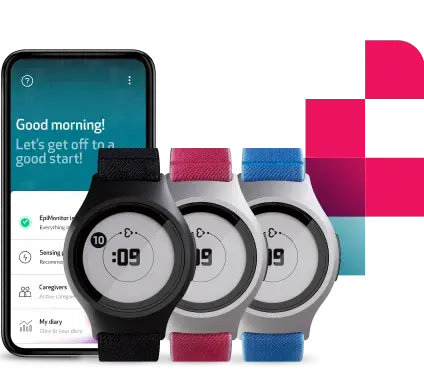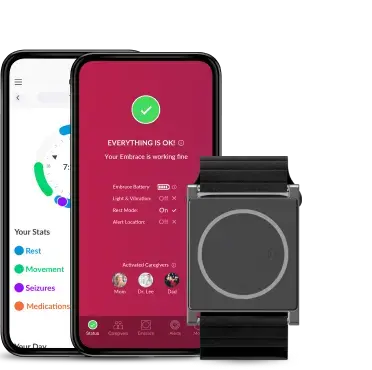Our highlights from AES 2019
The American Epilepsy Society’s (AES) Annual Meeting is the world’s largest meeting and exhibition for professionals who share common scientific and clinical interests in epilepsy. Empatica had its strongest presence ever at this year’s meeting in Baltimore, and through this post, we look back on some of our highlights.
I. Unveiling Remote Seizure Monitoring
Visitors who came to our booth had the opportunity to be the first to experience our brand new Remote Seizure Monitoring solution in person. Remote Seizure Monitoring has been created with the physicians’ needs in mind, to help inform medical decisions without the need to rely on incomplete, hastily-put-together paper diaries. The initial interest has been enormous, proving that remote monitoring using wearable devices is being recognized as an exciting new area in medicine which can have a major, positive impact on patients’ lives. Providers can share their details with us to be updated or declare their interest in participating as we begin to roll out the service.
II. Hot Topics: SUDEP and Wearables
The recent, tragic passing of Disney actor Cameron Boyce appears to have made an impact in the community when it comes to SUDEP awareness. SUDEP remains the uncomfortable, inconvenient truth in epilepsy, but more than ever before, charities, physicians, and professors bring up its heartbreaking likelihood, the causes behind it, but also the crucial role that monitoring technology can play in preventing it, by ensuring someone can come to assist a person who has just had a seizure.
At the Hot Topics Symposium we attended, there were two main stand-outs: (1) SUDEP and (2) Wearables. The main takeaways were that:
- Doctors and nurses should be telling patients about the low but real risk of SUDEP
- It is established that SUDEP is less likely if a person is not alone when a seizure happens (although it is not 100% preventative of SUDEP, even if a medical professional is there)
- There has been a lot of progress in wearables with two FDA-cleared devices available in the marketplace now
The speaker emphasized how Empatica Embrace, in particular, had achieved significantly better false alarm rates, and he cited the scientific work of our own Dr. Regalia and the Empatica data team.
III. We were invited to attend a private meeting: Toward developing a future Seizure Gauge
The Epilepsy Foundation has learned in a survey that the #1 request of patients, other than not having seizures, is being able to forecast when a seizure might happen. Last year, they funded a competition for teams to present a plan to build a “seizure gauge” that would try to provide patients with their personal seizure forecast. This “by invitation only” private meeting at AES consisted of a series of presentations, two of which we highlight:
(1) The winning team (funded to build a Seizure Gauge) gave a presentation of their first year of work, which included a large study testing more than six different wearable devices for providing data for creating the forecast. They had examined which devices were most comfortable for long-term data collection and which collected the best quality data. We were thrilled to see their results after testing all of the devices: Empatica’s E4 was the clear winner!
They have now chosen to use Empatica’s wearables for collecting their scientific data for the rest of their study. This is a huge achievement that recognizes the non-stop, hard work of Empatica’s engineering to build and manufacture the highest quality devices that deliver reliable, accurate, and secure data.
(2) Our CEO, Matteo Lai, gave an invited presentation on “What’s in the pipeline for the future?” He presented the design of the new EmbracePlus and the many improvements it makes over the E4. The attendees asked him many questions and showed great enthusiasm for how the EmbracePlus, when it arrives next year, will enable them to do even more than the E4 enables. The EmbracePlus will ensure long-term comfort and usability while providing even better quality physiological data than ever available before.
IV. Officially a near-zero false alarm rate during rest for Embrace2
The Empatica poster this year focused on the multimodal detection of generalized tonic-clonic seizures, proving once again that the combination of movement data and EDA (Electrodermal Activity) can yield significantly accurate results in the detection of GTCS. The highlight, however, was the confirmation of the incredibly low number of false positives that Embrace2 can detect during periods of rest, which includes time at home and sleeping. The overall false alarm rates (FARs) during rest periods were 0.05 and 0.02 in pediatrics and adults, respectively.
As you can tell, we had a very exciting and packed schedule at AES this year. We thank all of the participants and attendees that stopped by our booth and listened to our presentations. We look forward to future collaborations, and we’ll see everyone next year!
Words worth reading
We do not guarantee that EpiMonitor will detect every single seizure and deliver alerts accordingly. It is not meant to substitute your current seizure monitoring practices, but rather to serve as a supplement in expediting first-response time.



